 |
 |
What We See When We Look at China
"China: Fifty Years Inside the People's Republic"
At Asia Society through January 2
By Douglas C. McGill
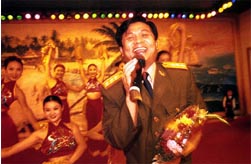 |
Army colonel in floor show
Brian Palmer, Haikou, 1997 |
"Writing about jazz is like dancing about architecture," a jazz lover skeptical of music critics once said. One could be equally skeptical of taking photographs of China, a nation so vast that the pinhole of a camera lens would hardly seem a grand enough instrument to record it truly.
Yet capturing a genuine image of China is precisely the ambition of a remarkable collection photographs at the Asia Society called "China: Fifty Years Inside the People's Republic." The collection's 166 images by 30 photographers vividly illustrate a wide spectra of modern Chinese life - urban to rural, personal to public, bedroom to boardroom, from Sunday at church to Saturday at the vegetable market.
It's a China that Western eyes aren't used to seeing. A series of photographs called "Secret Catholics" shows a peasant toting a plaster statue of the Virgin Mary. It looks like a scene from the rubble-strewn streets of Catholic El Salvador or Nicaragua, but not from China. A picture of the Gobi desert, with sand dunes topped with wind-sculpted ridges and embedded with partially buried tombs resembling nuclear bunkers looks, simply, surreal.
Photographer Artists
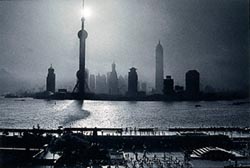 |
View of Pudong district
from the Bund
Sebastião Salgado, Shanghai, 1998 |
Eerie familiarity mixed with the breathtakingly strange is, of course, the hallmark of Western photographic images of the Orient, and has been for decades. The most fascinating part of this exhibition is how it updates that tradition, which began with mid-19th century photographs taken by traders and missionaries to China like John Thomson and Felice Beato. It continued with works by wealthy dilettantes like Eliot Porter and Sidney D. Gamble; and was carried on during the first decades of the PRC by daring photojournalists like Robert Capa, Carl Mydans, and Marc Riboud.
So just how are Westerners seeing China differently these days? Based on the evidence in this show, in two principal ways. First, whether they are Australians or Europeans or Americans, photojournalists or professors or business executives, photographers of China are seeing the country very self-consciously as artists. When Thomson and Beato were lugging their 80-pound tripod-mounted cameras around China in the middle 1800's their aesthetics were shaped more by post-Impressionist and Hudson River school painters than by photographers -- if they thought of art at all.
Ordinary Life
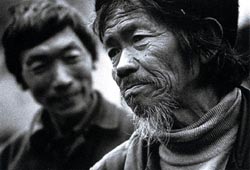 |
from the series "Yun Yang"
Richard Yee, Yunnan Province, 1997 |
For several decades now, by contrast, the aesthetic styles of the 20th century photography masters - Stieglitz, Steichen, Weston, Evans, Bourke-White, Smith, Capa - as well as prominent contemporary photojournalists and commercial photographers (e.g., Frank, Meiselas, Mark, Clark, Leibovitz, Avedon) have been so thoroughly ingrained that late 20th century China is inevitably being seen, no matter who takes the pictures, through their eyes.
Until the middle 1950s, photography in China was largely posed, documentary, and unselfconscious. In this show, for all of the obviously earnest intentions of the photographers to shoot "straight," their images betray one after another hip-in-spite-of-themselves references to art photography, TV soap operas, news magazines, or celebrity tabloids.
This fractured and manufactured way of seeing has accompanied, and perhaps also helped to engender, the second shift in the way that Westerners are seeing China in the late 20th century: they embrace the mundane.
Open China
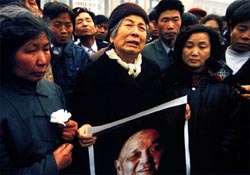 |
Mourners at Deng Xiaoping Memorial
Brian Palmer, Beijing, 1997 |
"The grand theme is lunch," said Brian Palmer, one of the photographers in the Asia Society exhibit, while narrating a slide show talk about his work at the society last week. On the screen behind him flashed a series of photographs of the hole-in-the-wall restaurant where Palmer, then the U.S. News and World Report Beijing bureau chief, ate his daily meals.
There are likely several reasons for the romance of the modern China photographer (Lois Conner's pictures notwithstanding) with daily life. One is very clearly the sense of freedom to explore that so many photographers have indulged since Deng Xiaoping opened China more fully to the West. China was closed to foreigners under Mao and for several years after his death. With travel within China much easier now, photographers have fanned throughout the country to see what's been hidden for many years.
Another reason, and a key to this show, is that many of the photographers whose work is on display are American-born Chinese. Reagan Louie, for instance, is the son of a Chinese immigrant who moved to California and opened a grocery store called "The American Way." Reagan was named for you can guess who, and his brother was named Eddie, after the movie star Eddie Fisher. Now a photojournalist, Louie writes in a wall text accompanying his photographs that he began a series of long visits to China in 1980 to explore his ancestral homeland. Those trips, he writes, gave him "both the art and the sense of connection that I so hungered for."
Laundry Lines
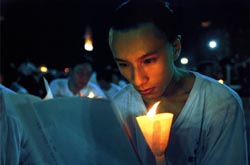 |
Hong Kong hand-over memorial
service
Brian Palmer, Victoria Park, 1997 |
China's early Western photographers loved studio portraits of wealthy dowagers dripping with jewels; streetfuls of pony tailed merchants holding up filigreed birdcages; and breathtaking views of the Great Wall.
In this show, which tends to focus on the economically booming China under Deng Xiaoping circa 1980 to the present, you see laundry lines hung with T-shirts and underwear; students reading under the street lamps in Tiananmen Square; women at an outdoor market in Suzhou scrutinizing chiffon scarves in a scene that looks not too different from one at K-Mart.
This quotidian approach lacks grandeur, and this show affords no special insight into the lives of China's rich and powerful. But certain advantages are gained. There is a great deal of information - historical, cultural, sociological -- revealed by photographs of daily life on close examination.
Ecce Homo
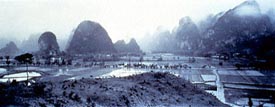 |
Yue Liang Shan
Lois Conner, Guangxi Province, 1985 |
Why are those students, hundreds of them, sitting on the hard pavement of Tiananmen Square in the dead of night? Because in 1981, the year that photographer Liu Heung Shing took the picture, very few homes in Beijing had electric lights to read by at night.
There is also the one-world feeling that scenes from ordinary life can evoke. Pictures of kids and families and ordinary folk can be clichéd "family of man" snaps all too easily. But done with discipline and heart, photographs of daily life can do what no other art does so well: remind us we're one.
Ecce homo: a young Chinese man holds a flickering candle to remember the dead at Tiananmen Square; a proud mother shows her son a medal she won for being a model worker; an Army colonel in dress greens and gold-braided epaulets croons like Elvis at a karaoke bar in Haikou, or is it Harrisburg?
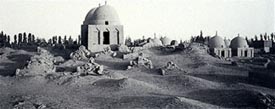 |
Gobi Shamo
Lois Conner, Gansu Province, 1995 |
The photographs in this show -- brilliant and ordinary, often literally wallowing in the mud but on occasion flashing with color and warmth and worry and wit -- show Chinese in the full frontal act of being human.
|
See the photos online or in-person
Funded by a grant from the Ford Motor Co., "China: Fifty Years Inside the People's Republic" will continue at Asia Society in New York City until January 2. It will be at the Royal Ontario Museum in Ontario, Canada, from January 15 to March 26; at the University of California Berkeley Art Museum from April 12 to June 18; and at museums in Naples, Italy; Minneapolis, Minnesota; Manchester, England; Coral Gables, Florida; Washington, D.C.; and London, England until 2004.
From Dec. 12 to January 23, the photographs will be shown at the National Museum of Chinese History in Beijing; and in April and May they will be on view at the Shanghai Museum of Art.
|
© Virtual China Inc. 1999
|
 |

